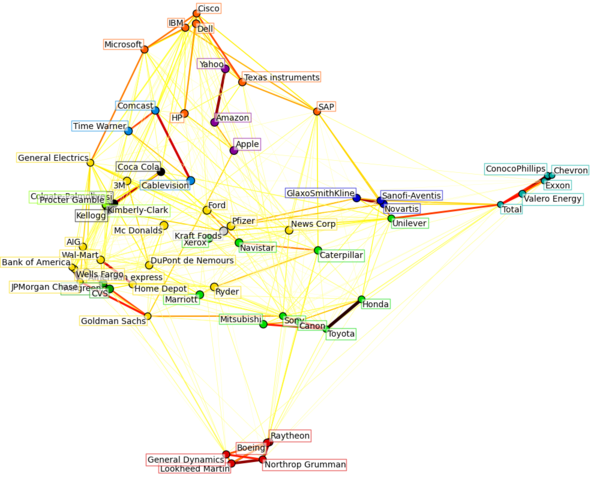分析股票价格共振网络
跳到导航
跳到搜索
准备一批股票数据
先调用一些包
import datetime
import numpy as np
import pylab as pl
from matplotlib import finance
from matplotlib.collections import LineCollection
from sklearn import cluster, covariance, manifold
接着确定时间段和股票名称,使用sklearn自带的finance.quotes_historical_yahoo命令来下载数据。以下命令中带井号的是测试时发现下载有问题的。
# ======Retrieve the data from Internet=========
# Choose a time period reasonnably calm (not too long ago so that we get
# high-tech firms, and before the 2008 crash)
d1 = datetime.datetime(2003, 01, 01)
d2 = datetime.datetime(2008, 01, 01)
# kraft symbol has now changed from KFT to MDLZ in yahoo
symbol_dict = {
'TOT': 'Total',
'XOM': 'Exxon',
'CVX': 'Chevron',
'COP': 'ConocoPhillips',
# 'VLO': 'Valero Energy',
'MSFT': 'Microsoft',
'IBM': 'IBM',
# 'TWX': 'Time Warner',
# 'CMCSA': 'Comcast',
'CVC': 'Cablevision',
'YHOO': 'Yahoo',
# 'DELL': 'Dell',
'HPQ': 'HP',
'AMZN': 'Amazon',
'TM': 'Toyota',
'CAJ': 'Canon',
'MTU': 'Mitsubishi',
'SNE': 'Sony',
'F': 'Ford',
'HMC': 'Honda',
'NAV': 'Navistar',
'NOC': 'Northrop Grumman',
'BA': 'Boeing',
# 'KO': 'Coca Cola',
'MMM': '3M',
'MCD': 'Mc Donalds',
'PEP': 'Pepsi',
'MDLZ': 'Kraft Foods',
# 'K': 'Kellogg',
'UN': 'Unilever',
'MAR': 'Marriott',
'PG': 'Procter Gamble',
'CL': 'Colgate-Palmolive',
# 'NWS': 'News Corp',
'GE': 'General Electrics',
'WFC': 'Wells Fargo',
'JPM': 'JPMorgan Chase',
'AIG': 'AIG',
'AXP': 'American express',
'BAC': 'Bank of America',
'GS': 'Goldman Sachs',
'AAPL': 'Apple',
'SAP': 'SAP',
'CSCO': 'Cisco',
'TXN': 'Texas instruments',
'XRX': 'Xerox',
'LMT': 'Lookheed Martin',
'WMT': 'Wal-Mart',
'WAG': 'Walgreen',
'HD': 'Home Depot',
'GSK': 'GlaxoSmithKline',
'PFE': 'Pfizer',
'SNY': 'Sanofi-Aventis',
'NVS': 'Novartis',
'KMB': 'Kimberly-Clark',
'R': 'Ryder',
'GD': 'General Dynamics',
'RTN': 'Raytheon',
'CVS': 'CVS',
'CAT': 'Caterpillar',
# 'DD': 'DuPont de Nemours'
}
symbols, names = np.array(symbol_dict.items()).T
quotes = [finance.quotes_historical_yahoo(symbol, d1, d2, asobject=True)
for symbol in symbols]
open = np.array([q.open for q in quotes]).astype(np.float)
close = np.array([q.close for q in quotes]).astype(np.float)
variation = close - open
构建网络
现在,我们要根据股票价格变动之间的相关性来得到一个相关性矩阵,并且通过确定阈值来将这个矩阵变成一个邻接矩阵,以得到一个网络。
# Learn a graphical structure from the correlations
edge_model = covariance.GraphLassoCV()
# standardize the time series: using correlations rather than covariance
# is more efficient for structure recovery
X = variation.copy().T
X /= X.std(axis=0)
edge_model.fit(X)
识别社区
我们使用Affinity Propagation的方法在这个网络上划分社区。使用AP的好处是它聚类时不用预先给出cluster的个数。
_, labels = cluster.affinity_propagation(edge_model.covariance_)
n_labels = labels.max()
for i in range(n_labels + 1):
print('Cluster %i: %s' % ((i + 1), ', '.join(names[labels == i])))
绘制网络
绘制网络包括一系列步骤:
首先要给节点选定合适的位置。我们的思路是使用manifold.LocallyLinearEmbedding的方法将股票的协方差数据(1258维)降到二维,分别作为xy坐标绘制股票。
_, labels = cluster.affinity_propagation(edge_model.covariance_)
n_labels = labels.max()
for i in range(n_labels + 1):
print('Cluster %i: %s' % ((i + 1), ', '.join(names[labels == i])))
然后根据我们生产的节点坐标,绘制网络。在这个过程中,还要让同一个社区的节点颜色保持一致,并且要求节点的标签不与节点重合。
# Find a low-dimension embedding for visualization: find the best position of
# the nodes (the stocks) on a 2D plane
# We use a dense eigen_solver to achieve reproducibility (arpack is
# initiated with random vectors that we don't control). In addition, we
# use a large number of neighbors to capture the large-scale structure.
node_position_model = manifold.LocallyLinearEmbedding(
n_components=2, eigen_solver='dense', n_neighbors=6)
embedding = node_position_model.fit_transform(X.T).T
# Visualization
pl.figure(1, facecolor='w', figsize=(10, 8))
pl.clf()
ax = pl.axes([0., 0., 1., 1.])
pl.axis('off')
# Display a graph of the partial correlations
partial_correlations = edge_model.precision_.copy()
d = 1 / np.sqrt(np.diag(partial_correlations))
partial_correlations *= d
partial_correlations *= d[:, np.newaxis]
non_zero = (np.abs(np.triu(partial_correlations, k=1)) > 0.02)
# Plot the nodes using the coordinates of our embedding
pl.scatter(embedding[0], embedding[1], s=100 * d ** 2, c=labels,
cmap=pl.cm.spectral)
# Plot the edges
start_idx, end_idx = np.where(non_zero)
#a sequence of (*line0*, *line1*, *line2*), where::
# linen = (x0, y0), (x1, y1), ... (xm, ym)
segments = [[embedding[:, start], embedding[:, stop]]
for start, stop in zip(start_idx, end_idx)]
values = np.abs(partial_correlations[non_zero])
lc = LineCollection(segments,
zorder=0, cmap=pl.cm.hot_r,
norm=pl.Normalize(0, .7 * values.max()))
lc.set_array(values)
lc.set_linewidths(15 * values)
ax.add_collection(lc)
# Add a label to each node. The challenge here is that we want to
# position the labels to avoid overlap with other labels
for index, (name, label, (x, y)) in enumerate(
zip(names, labels, embedding.T)):
dx = x - embedding[0]
dx[index] = 1
dy = y - embedding[1]
dy[index] = 1
this_dx = dx[np.argmin(np.abs(dy))]
this_dy = dy[np.argmin(np.abs(dx))]
if this_dx > 0:
horizontalalignment = 'left'
x = x + .002
else:
horizontalalignment = 'right'
x = x - .002
if this_dy > 0:
verticalalignment = 'bottom'
y = y + .002
else:
verticalalignment = 'top'
y = y - .002
pl.text(x, y, name, size=10,
horizontalalignment=horizontalalignment,
verticalalignment=verticalalignment,
bbox=dict(facecolor='w',
edgecolor=pl.cm.spectral(label / float(n_labels)),
alpha=.6))
pl.xlim(embedding[0].min() - .15 * embedding[0].ptp(),
embedding[0].max() + .10 * embedding[0].ptp(),)
pl.ylim(embedding[1].min() - .03 * embedding[1].ptp(),
embedding[1].max() + .03 * embedding[1].ptp())
#pl.show()
最后得到的图如下所示
